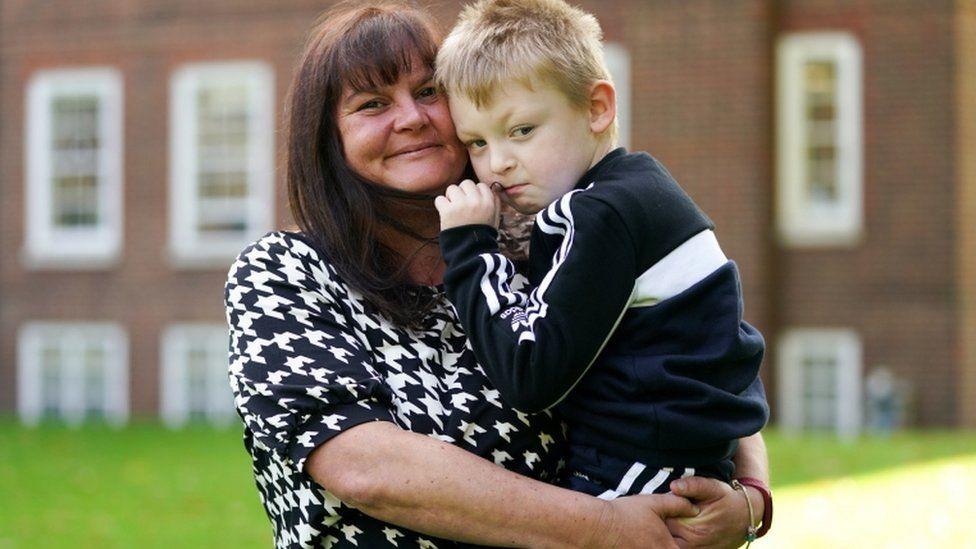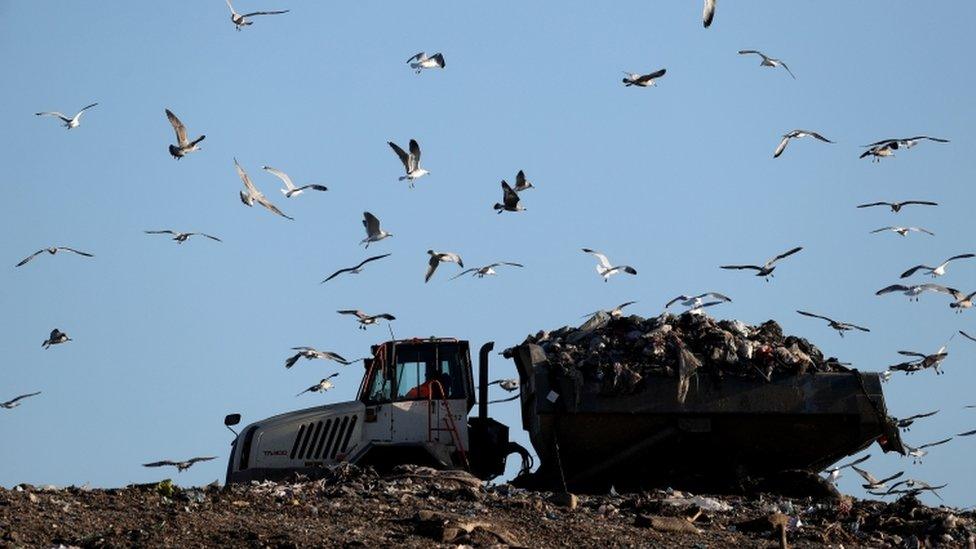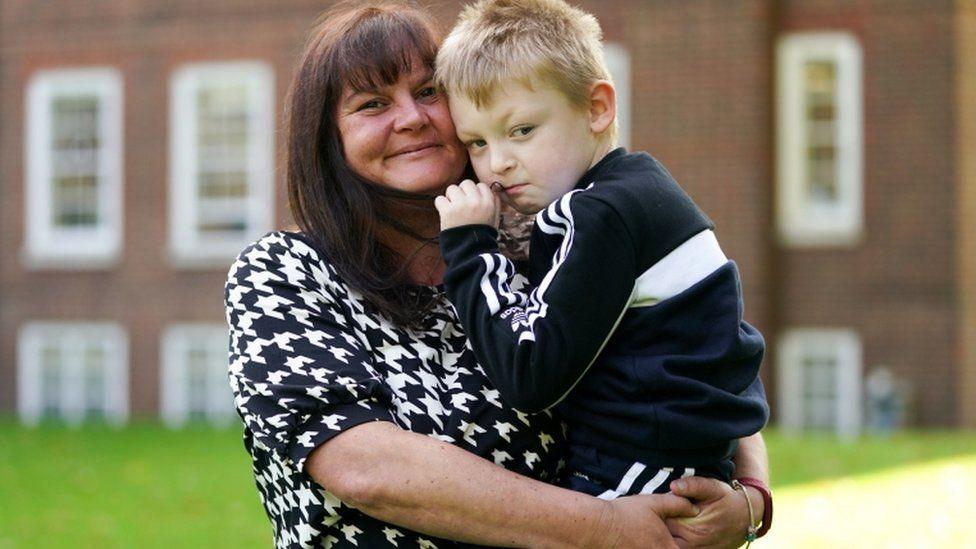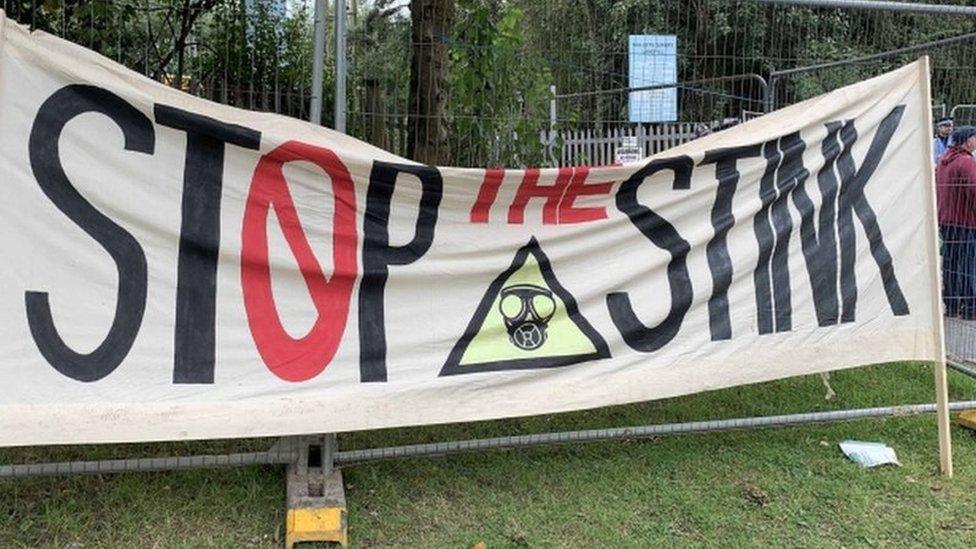Silverdale Walleys Quarry landfill continues to prompt complaints
- Published

Lawyers for Walleys Quarry Ltd said "continuous improvements" were being made at the site
More than 1,000 complaints were made in the first three months of this year about the smell coming from a controversial landfill site.
There had already been more than 70,000 complaints about Walley's Quarry, in north Staffordshire, by the end of 2022.
Residents living near the site say hydrogen sulphide levels are affecting their health.
Walleys Quarry Ltd, which operates the landfill, says since the beginning of 2022 emissions have been significantly reduced.
Up to 400,000 tonnes of waste is dumped in Walleys Quarry landfill every year. When waste breaks down, it can produce a gas called hydrogen sulphide which smells like rotten eggs.
At high concentrations it is toxic and can cause breathing difficulties.

Mathew lives about a quarter of a mile from Walleys Quarry with his mother Rebecca Currie
Mathew, who is seven years old, has always lived near Walleys in Silverdale, Staffordshire. He was born prematurely with a chronic lung disease unrelated to the landfill.
His mother, Rebecca Currie is convinced her son's underlying health problems have been made worse by emissions of hydrogen sulphide gas coming from the landfill.
She told Panorama: "He was coughing that viciously, he was vomiting, so you're up, changing his bedding."
She was so worried, that in 2021 she began filming him at night. She said: "My fear has always been going into his bedroom in the morning and you know it's been fatal, because that's how bad the cough and the retching has been."
Consultant paediatrician Dr Martin Samuels of University Hospitals of North Midlands has assessed Mathew. "I think the environmental impact has been significant," he said. "It's been a struggle for us to treat him, and I think the gas has been a very likely factor in all of that."
Walleys Quarry is one of 550 landfill sites in the UK. In England, these sites are regulated by the Environment Agency. In March 2021, it installed air quality monitors around the Staffordshire landfill.
Over the next 12 months results showed hydrogen sulphide levels had repeatedly breached World Health Organization (WHO) odour annoyance guidelines.
Local GPs in Silverdale also reported seeing patients who said they had symptoms brought on by the gas. One, Dr Paul Scott from the Silverdale Village Surgery said: "Some were coming in with a real trouble with the physical symptoms, with the effects on their eyes, the nose. Kind of hay fever type symptoms.
"Some patients with asthma or breathing issues were coming in, needing their medication, slightly upped."

Allegations about the site were raised by local MP Aaron Bell in 2022
The Royal Stoke University Hospital made an official complaint to Newcastle under-Lyme Borough Council and the NHS offered special mental health support for those affected by the smell.
"Part of mental health always is your quality of sleep, and if you're being woken in the middle of the night, eyes streaming and coughing and whatever, that is really distressing," added Dr Scott.
Using parliamentary privilege, the Conservative MP for Newcastle-under-Lyme Aaron Bell has alleged that hazardous substances including rat poison and cavity wax used in the manufacture of cars, had been illegally dumped at Walleys Quarry.
He told Parliament that the claims were based on internal emails leaked by a whistleblower who used to work for the parent company of Walleys Quarry, Red Industries.
Walleys Quarry Ltd said it "wholly and unequivocally refutes all allegations of wrongdoing in the conduct of its business", adding any such allegations are "false and malicious".
Some residents living near the landfill site have accused the Environment Agency of not taking sufficiently robust action against Walleys Quarry Limited.
In 2021, legal action against the regulator was launched by Mrs Currie, Mathew's mother. Lawyers successfully argued at the High Court that hydrogen sulphide gas had worsened the seven-year-old's underlying health issues, and that emissions were affecting hundreds and probably thousands of local people.
The court ordered the Environment Agency to do more to control emissions, but the ruling was overturned on appeal. No appeal was made against the original finding that Mathew's health issues had been exacerbated by hydrogen sulphide.
The Environment Agency has the powers to shut landfill sites down, and John Galvin, who used to work in waste regulation for the Government at the Department for Environment, Food and Rural Affairs (Defra) believes the regulator can often be too slow to act. He said there had been a "reticence to take hard enforcement action against those who don't come readily and quickly into the fold".

Residents have staged numerous protests over the landfill site
In March, this year the Environment Agency said conditions at Walleys Quarry had improved and hydrogen sulphide levels on the site are now less than a quarter of what they were in 2021.
But in the last week of April levels of the gas had risen again and the Environment Agency received nearly 300 complaints about the smell.
'Still under siege'
Emma Viner who is an enforcement and investigations manager for the regulator said breaches of odour annoyance guidelines were unacceptable "and that's what we are working to stop".
"There is obviously going to be a level of odour associated with the landfill site, but we will make sure that is within the acceptable levels and that's what our regulation and enforcement aims to achieve," she said.
Another Silverdale resident Lee Bernadette Walford said people living near the site were "still under siege".
"We are still being affected by the smell and although the data has got better, it's still there. It's still not good enough."
In a statement, Walleys Quarry Ltd said it, "remains committed to significant investment in onsite improvement works".
"These have already resulted in demonstrable, substantial and sustained progress. The Environment Agency's own reporting data shows significant long term reductions in emissions and complaints have fallen by 90%," it added.
"Walleys Quarry Limited will always seek to work with all relevant regulatory, local, national bodies and most importantly, our neighbours, to alleviate concerns and provide a clean, healthy and sustainable operation that supports our community."
Walleys Quarry will continue operating until it reaches capacity in 2026.
You can see more on that story on Panorama, Landfill: Britain's Toxic Secrets, on BBC One from 20:00 BST and iPlayer 06:00.

Panorama: Landfill: Britain's Toxic Secrets
Every year, millions of tonnes of waste are dumped in landfill sites, but how safe are they? Reporter Amber Haque investigates a Staffordshire landfill which residents claim has affected their health and examines the potentially toxic legacy of historic landfill sites.

Related topics
- Published3 February 2022

- Published3 February 2022

- Published17 January 2022

- Published17 December 2021

- Published14 December 2021

- Published15 October 2021

- Published5 October 2021

- Published16 September 2021
